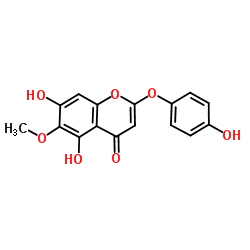| Description |
Capillarisin, as a constituent from Artemisiae Capillaris herba, is found to exert anti-inflammatory and antioxidant properties. Capillarisin can be used for the research of asthma-mediated complications and can be a potential neuroprotectant against bupivacaine-induced neurotoxicity[1][2][3].
|
| Related Catalog |
|
| In Vitro |
Capillarisin (0~40 μM; 24 hours; SH-SY5Y cells) does not produce any significant changes on the viability of SH-SY5Y cells[3]. .Capillarisin (40 μM; 24 hours; SH-SY5Y cells) induces PI3K/PKB pathway inactivation, which inhibiting apoptosis in bupivacaine-challenged SH-SY5Y cells is overturned by LY294002 treatment and counteracts bupivacaine-induced injury via activating the PI3K/PKB pathway[3]. .Capillarisin antagonizes bupivacaine-induced oxidative stress via activating the PI3K/PKB pathway in SH-SY5Y cells. Capillarisin inhibits bupivacaine-induced mitochondrial injury and endoplasmic reticulum stress via activating PI3K/PKB pathway[3]. Cell Viability Assay[3] Cell Line: SH-SY5Y cells Concentration: 0~40 μM Incubation Time: 24 hours Result: Did not produce any significant changes on the viability of SH-SY5Y cells. Western Blot Analysis[3] Cell Line: SH-SY5Y cells Concentration: 40 μM Incubation Time: 24 hours Result: Induced PI3K/PKB pathway inactivation in SH-SY5Y cells. Apoptosis Analysis[3] Cell Line: SH-SY5Y cells Concentration: 40 μM Incubation Time: 24 hours Result: Induced inhibition of apoptosis in bupivacaine-challenged SH-SY5Y cells was overturned by LY294002 treatment.
|
| In Vivo |
Capillarisin (20 and 80 mg/kg; i.p.; 1 hour) pretreatment strongly inhibits NF-κB mediated genes (iNOS, COX-2)[4]. Capillarisin significantly reduces the plasma leading nitrite production. Capillarisin markedly suppresses the adenosine 5'-triphosphate (ATP) in plasma and substance P in CFA-induced paw tissue[4]. Animal Model: ICR mice[4] Dosage: 20 and 80 mg/kg Administration: I.p.; 1 hour Result: Pretreatment strongly inhibited NF-κB mediated genes (iNOS, COX-2).
|
| References |
[1]. Peng G, et al. Capillarisin exerts antiasthmatic activity in neonatal rats via modulating the matrix remodeling. Pak J Pharm Sci. 2020;33(4(Supplementary)):1907-1915. [2]. Komiya T, et al. Capillarisin, a Constituent from Artemisiae Capillaris Herba. Chemical and Pharmaceutical Bulletin, 1975 [3]. Zhao T, Wang Q. Capillarisin protects SH-SY5Y cells against bupivacaine-induced apoptosis via ROS-mediated PI3K/PKB pathway. Life Sci. 2020;259:118279. [4]. Khan S, et al. Anti-hyperalgesic and anti-allodynic activities of capillarisin via suppression of inflammatory signaling in animal model. J Ethnopharmacol. 2014;152(3):478-486.
|


